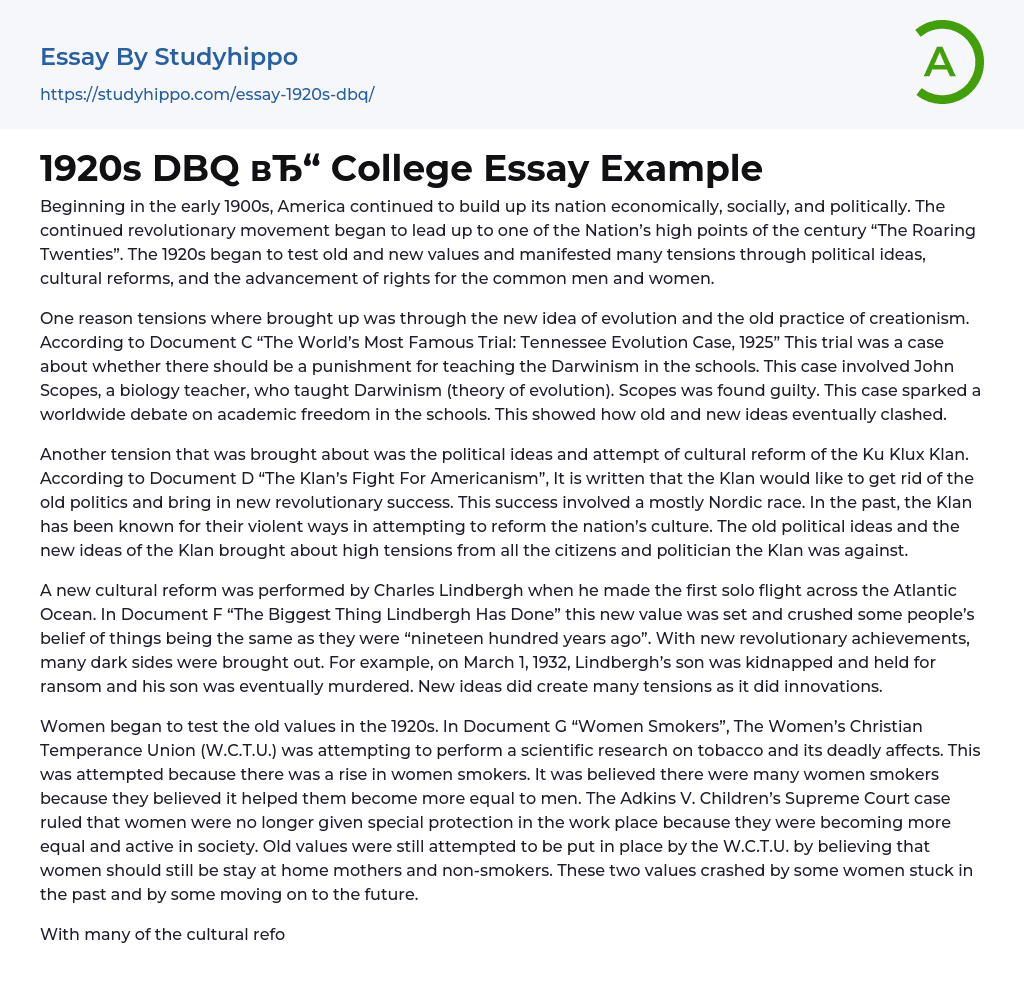Beginning in the early 1900s, America continued to build up its nation economically, socially, and politically. The continued revolutionary movement began to lead up to one of the Nation’s high points of the century “The Roaring Twenties”. The 1920s began to test old and new values and manifested many tensions through political ideas, cultural reforms, and the advancement of rights for the common men and women.
One reason tensions where brought up was through the new idea of evolution and the old practice of creationism. According to Document C “The World’s Most Famous Trial: Tennessee Evolution Case, 1925” This trial was a case about whether there should be a punishment for teaching the Darwinism in the schools. This case involved John Scopes, a biology teacher, who taught Darwinism (theory of evol
...ution). Scopes was found guilty. This case sparked a worldwide debate on academic freedom in the schools. This showed how old and new ideas eventually clashed.
Another tension that was brought about was the political ideas and attempt of cultural reform of the Ku Klux Klan. According to Document D “The Klan’s Fight For Americanism”, It is written that the Klan would like to get rid of the old politics and bring in new revolutionary success. This success involved a mostly Nordic race. In the past, the Klan has been known for their violent ways in attempting to reform the nation’s culture. The old political ideas and the new ideas of the Klan brought about high tensions from all the citizens and politician the Klan was against.
A new cultural reform was performed by Charles Lindbergh when he made the
first solo flight across the Atlantic Ocean. In Document F “The Biggest Thing Lindbergh Has Done” this new value was set and crushed some people’s belief of things being the same as they were “nineteen hundred years ago”. With new revolutionary achievements, many dark sides were brought out. For example, on March 1, 1932, Lindbergh’s son was kidnapped and held for ransom and his son was eventually murdered. New ideas did create many tensions as it did innovations.
Women began to test the old values in the 1920s. In Document G “Women Smokers”, The Women’s Christian Temperance Union (W.C.T.U.) was attempting to perform a scientific research on tobacco and its deadly affects. This was attempted because there was a rise in women smokers. It was believed there were many women smokers because they believed it helped them become more equal to men. The Adkins V. Children’s Supreme Court case ruled that women were no longer given special protection in the work place because they were becoming more equal and active in society. Old values were still attempted to be put in place by the W.C.T.U. by believing that women should still be stay at home mothers and non-smokers. These two values crashed by some women stuck in the past and by some moving on to the future.
With many of the cultural reforms in the 1920s, home life and marriages were deeply affected. According to the Document H Chart “MARRIAGE AND DIVORCE” it shows the incline of marriages to the peak being the 1920s and then a sudden drop. It also shows divorces slowly rising also. In the house holds of the 1890-1910,
old tensions about fewer jobs and less income caused fewer marriages. With the height of the economy in the 1920s, more people began to get married because of values. Then, during the great depression, new tensions arrived, marriages lessened, and divorces arose. Another new tension that caused the decline of marriages was when women obtained the right to vote. This made women more equal to men and gave them more power therefore; more men became disinterested because most of them wanted the regular housewife. This political idea and new tension slowly downturned marriages and increased divorces.
In conclusion, “The Roaring Twenties” were a time where old and new tensions met and manifested. The ever changing attitudes of this time created these were between the traditional values and the nostalgia. Even though the 1920s had its many tensions, it still had one of the biggest revolutionary movements of the century.
- 1920S essays
- 1950S essays
- 1960S essays
- 19Th Century essays
- 20Th Century essays
- Ancient Greece essays
- Bravery essays
- British Empire essays
- Civilization essays
- Colonialism essays
- Declaration of Independence essays
- Evidence essays
- Genocide essays
- Gilded Age essays
- Historical Figures essays
- Historiography essays
- History of the United States essays
- Letter from Birmingham Jail essays
- Louisiana Purchase essays
- Nazi Germany essays
- Rebellion essays
- Revolution essays
- Roman Empire essays
- Russian Empire essays
- The Columbian Exchange essays
- Vikings essays
- War essays
- What is History essays
- World History essays
- World Hunger essays
- Adoption essays
- Aunt essays
- Babies essays
- Bedroom essays
- Caring essays
- Children essays
- Daughter essays
- Divorce essays
- Dog essays
- Dysfunctional Family essays
- Family Tradition essays
- Family Values essays
- Father essays
- Foster Care essays
- Friends essays
- Grandparent essays
- Home essays
- Hometown essays
- Husband essays
- Jealousy essays




